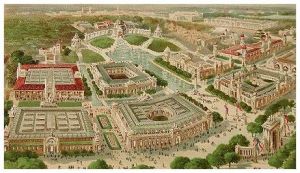Main Page: Difference between revisions
No edit summary |
No edit summary |
||
| Line 37: | Line 37: | ||
For general information, visit [[At The Fair]] page for various topics. | For general information, visit [[At The Fair]] page for various topics. | ||
The world of [[1904]] was very different than today's. | |||
==Areas== | ==Areas== | ||
Revision as of 21:00, 13 November 2022
 Painting of the Main Picture | |
| Official Name | Louisiana Purchase Exposition |
|---|---|
| Theme | 100th Anniversary Celebration of the Louisiana Purchase |
| Location | Forest Park, Missouri |
| Fair President | David Rowland Francis |
| Dates | April 30th - December 1st, 1904 (215 days) |
| Hours | 9:00 AM - 10:00 PM |
| Area | 1,272 acres |
| Size | 9,500 feet long, 6,000 feet wide (roughly 2 square miles) |
| Cost | $50,000,000 (equivalent to $1,507,962,963 in 2021) |
| Daily Admission | 50 cents for adults, 25 cents for children |
| Total Attendance | 19,694,855 |
| Average Daily Attendance | 85,197 |
| Opening Day Attendance | 187,793, 178,423 paid |
| Best Month Attendance | September (3,651,873) |
| Number of Days to See Everything | 17-18 |
| Number of Buildings | 1,576 |
| Total Walkway & Roadways | 75 miles |
| Ice Plant Production | 300 tons of ice per day |
| Fair Security | Jefferson Guard |
| Landscape Architect | George E Kessler |
| Trees & Landscaping cost | $1,679,000 (equivalent to $50,637,396 in 2021) |
map test Informally known as The 1904 St. Louis World's Fair, The Louisiana Purchase Exposition, was arguably the grandest World's Fair ever, hosted by the fourth largest city in the United States St. Louis, Missouri, in 1904. Construction began in 1902, with an original target opening in 1903, but was ultimately delayed until 1904.
Opened on April 30, 1904, The Fair, celebrated the centennial of the Louisiana Purchase which more than doubled the size of the United States.
An army of over 10,000 laborers, head by designer George Kessler transformed the Fair's 1,272-acre site, which was located at the present-day western edge of Forest Park and the city of St. Louis as well as the campus of Washington University. It was the largest and most beautiful of the Victorian-era World's Fairs. Ex-mayor of St. Louis, David Rowland Francis, was the main driving force behind securing the Fair's financing, supervising its building, and the gathering of the Exposition's exhibits. He also served as the Exposition's president.
After the construction was finished, there was over 1,500 buildings on the fairgrounds, connected by some 75 miles of roads and walkways. It was said to be impossible to give even a hurried glance at the entire Fair in less than a week. The Palace of Agriculture alone covered some 20 acres.
For general information, visit At The Fair page for various topics. The world of 1904 was very different than today's.
Areas
The Fair can be broken into twelve areas, with many buildings contained in each area. (Click on area to visit)
Error: Image is invalid or non-existent.
- Main Picture - The central portion of the fair, hosting the Palaces
- The Pike - A mile-long amusement lane, similar to a midway.
- Plateau of States - An elevated plateau, where many of the State buildings were built.
- National Pavilion - Many international buildings were located here.
- Anthropology Area - Tribes of Native Americans were displayed in this area.
- Philippine Exhibit - The newly acquired Philippines were showcased here.
- Agriculture Area - Many outdoor exhibits based on farm life were hosted here.
- The Trail - A forested area with many attractions, and some state buildings.
- Mining Gulch - A natural valley filled with outdoor mining exhibits.
- Washington University - Contained many administration buildings, and attractions.
- Model City - A demonstration of urban planning.
- Support Buildings - The fair required many support structures to ensure operation.
- There were many ways to get Transportation at the fair.
